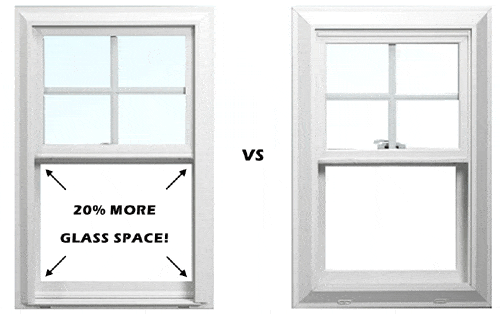So you picked out your new windows after doing all of your research. You ordered them then waited a few weeks for delivery and installation. The morning after the big day you’re walking around drinking a warm cup of coffee in your slippers admiring your fancy new windows. Then you notice that it feels a little darker in here than it used to. Is it cloudy outside? No, that’s not it. It turns out the glass area of your new windows is quite a bit smaller than your old windows and it looks like those fancy triple pane windows are also a little bit tinted. You hadn’t expected that, but there isn’t much that can be done about it now. This happens all the time and it’s exactly why visible transmittance is an important rating to consider.
The visible transmittance (or VT as it’s known) is a measure of how much light gets through the window. This is typically determined by the thickness of the frame and sash, but the coating or tint on the glass and any grids or muntins will also affect the ratings as they block some of the light.
Take a look at this picture of two relatively popular window models. These 2 windows are the exact same size and when they’re ordered with the same options they have the same efficiency ratings.

One of them sure does block a lot of light and I’d bet many of the folks ordering that product aren’t aware that they had another choice.
Why then would a company promote that thicker model if it’s not more efficient? As always is the case in life the answer isn’t as simple as you’d hope. That thicker window does allow for heavier triple pane glass where the thinner model can only offer double pane. For the customer who wants triple pane glass that represents a pretty good option. For the customer who wants double pane it makes no sense at all.
What’s the tricky sales tactic?
Unfortunately when there’s a good reason for something there’s typically also a bad reason. Some salespeople will use a cutaway piece of that thicker window to sell you on “strength” they’ll show you how it has 37 air chambers in the frame and talk about those “other” windows that use thinner weaker frames.
As you’ve probably guessed by now there is absolutely no reason that you’d need to take their word on something like this. The “strength” of a product is measured by the design pressure which will be covered in another post. Does this thicker window have a better/higher design pressure than the thinner one? Nope. They’re exactly the same.
So how do I compare the options?
In order to compare you’ll need to know what you’re comparing. Options like types of glass or grids will affect the ratings. One company might give you the rating with grids between the glass and another might give you the rating without. If you don’t know what you’re comparing you’ll be likely to misinterpret the information.
To make things relatively simple (everything is relative right?) I’d suggest comparing options without grids and with the glass option that you’re leaning towards. Taking the grids out of the equation will give you the info based on the frame size and the glass coating alone. If you will be ordering your windows with grids they will typically be almost exactly the same from one manufacturer to another so they won’t make much (if any) difference.
So what’s a good or a great rating?
Assuming you’re comparing energy star rated double pane windows a pretty good option will be in the range of 0.54 or better. Great options will be as high as 0.56.
Triple pane options will reduce the VT rating as the light needs to pass through 3 panes of glass and typically 2 low-e coatings. They will also often have thicker frames as shown in the pic above. A pretty good triple pane window will offer a VT of 0.42 or better, but some will go as low 0.30 depending on the window and the glass option. Remember a lower number means a darker living room so be sure you understand what you’re picking.
Getting a more efficient window does sometimes result in a lower VT so that’s a trade off you’ll need to consider. For me it’s a big deal as I love the sunlight, but other folks don’t care. It’s your house not mine; get whatever makes you happy!
If you’re looking for a window company right now, the best advice we have is to check out our list of the best window companies all over the country. You can find it right here.

